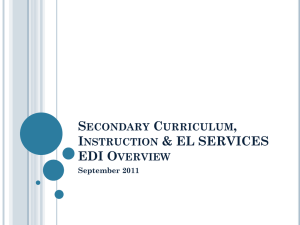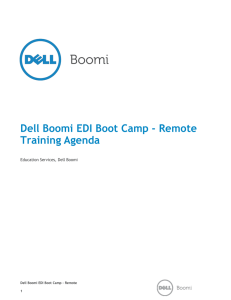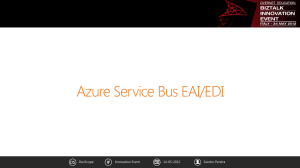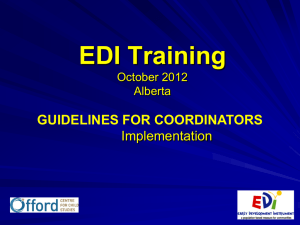Ysleta Coaches Training - United Way of El Paso County
advertisement
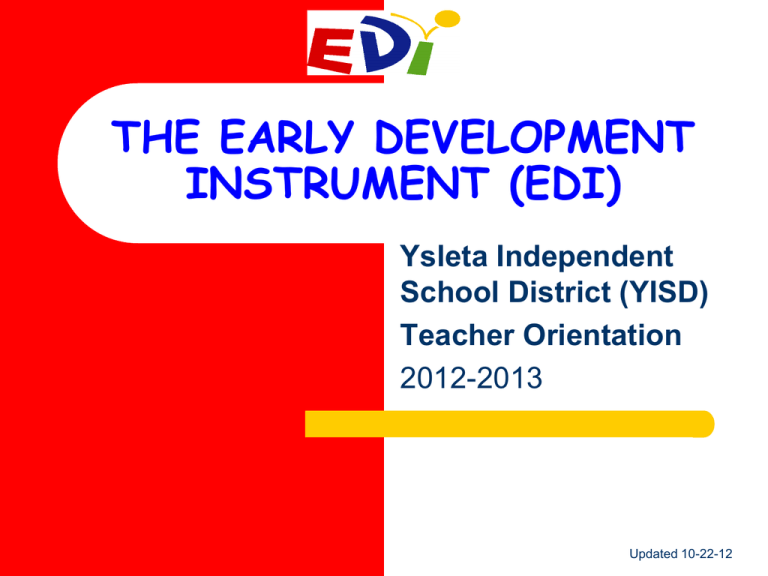
THE EARLY DEVELOPMENT INSTRUMENT (EDI) Ysleta Independent School District (YISD) Teacher Orientation 2012-2013 Updated 10-22-12 THE EARLY DEVELOPMENT INSTRUMENT (EDI) Teacher Orientation 2012-2013 Updated 10-22-12 Preface to EDI Teacher Orientation 3 Audience: Kindergarten teachers completing EDIs Intention: Supplement in person orientation conducted by your local EDI coordinator Local Logistics: There are a number of logistics that are unique to your community and should be provided to you by your local EDI coordinator. These include: – Confirmation that your community is participating in the EDI project – Guidelines on how parents are receiving the EDI parent letter – Indication of when you have the green light to begin filling out the EDI’s online for your class – Provision to you of a hard copy of a class list from your district or school – Any local deadlines for when the EDI work should be completed – Instructions on how to receive compensation for your time IF you are completing EDIs during off school hours. – Who to contact locally for questions about these types of logistical issues Objectives of the EDI Orientation 4 Describe the Early Development Instrument (EDI) Review steps for teachers in completing the EDI Walk through how to use the EDI software Provide contact information for questions National Partnership EDI Data 5 Engage Community around Informed Planning and Improvement Use of EvidenceBased Practices Improved Developmental Outcomes What You Know and Can Help Share 6 The EDI results can help quantify and bring attention to what you already know – Children are born ready to learn – The quality of children’s earliest environments and experiences are crucial to determining the brain’s development – The early years lay the foundation for long term health and education Early Development Instrument (EDI) 7 Provides a community measure of the developmental strengths and vulnerabilities of children Results from the EDI enable us to – Look forward to adjust school programs to meet the current needs of incoming students (schools) – Look backward to adjust early childhood service systems to help ensure children are ready to learn (community) EDI is reported on groups of children. It is not intended to be used as a diagnostic tool to screen or identify individual children Individual child information is confidential and cannot be shared with anyone, including parents EDI Continued 8 Research has found the EDI to be a valid and reliable measure for children’s development Based on a checklist completed by kindergarten teachers on each child in class 104 questions grouped into five domains Takes an average of 15 minutes per child EDI: Five Developmental Domains Domain Physical Health and Well-being Number of Items and Subdomains Child is healthy, independent, ready each day Items: 13 Subdomains: 3 Social Competence Child plays, gets along with others and shares, is self-confident Items: 26 Subdomains: 4 Emotional Maturity Child is able to concentrate, help others, is patient, not aggressive or angry Items: 30 Subdomains: 4 Child is interested in reading and writing, can count and recognize numbers, shapes Items: 26 Subdomains: 4 Language and Cognitive Development Communication Skills and General Knowledge 9 Description Child can tell a story, communicate with adults and children, articulate themselves Items: 8 Subdomain: 1 How Data is Reported 10 Confidential school report shows how children are doing developmentally in that school Community Profile Report shows how children are doing developmentally by neighborhood EDI School Report Template 11 EDI Community Profile Report Uses GIS Maps The EDI data maps allow stakeholders to compare children’s development – By geography to identify areas of greatest need – To socio-economic indicators, to help understand the reasons for observed outcomes – To service data to identify where there are service gaps 12 13 14 Anticipated Outcomes 15 Increase community awareness on the importance of early childhood development Inform planning and improvement activities Improve grant making, needs assessments and other activities that benefit from real local data Gain public support and political will to grow and sustain resources dedicated to early childhood Improve early childhood services and systems Improve outcomes for children 3 Steps for Teachers 1. Ensure that before you begin completing the EDIs on your students that the parent information letter has been sent. 2. Gather and review essential materials – – – – Class list from district for each class you teach Teacher Guide Teacher Instruction Sheet for US-EDI Software Sample EDI Checklist 3. Log into US-EDI teacher portal to complete the EDI forms 16 Filling out the EDI – General Guidelines Kindergarten teachers complete the EDI Checklist online Each EDI takes an average of 15 minutes to complete The EDI is based observational recall and on the teacher’s perception of the child’s development EDI is completed on every kindergartener except – – – 17 If teacher has known this child for less than 1 month If child is no longer in the class Other, such as the parent “opts out” If any of these exclusions exist, you will document it in question 14 and the survey for that child will end Filling out the EDI: Accuracy 18 It is very important that the EDI is answered in an accurate and consistent way across the country When answering the EDI, we ask you to consider the following: – Your observations of the student should reflect his/her CURRENT developmental status unless otherwise noted – Base your answers on expected skills and behaviors for this phase of development rather than how the child is doing relative to peers – Focus your observations on the specific skills or behaviors listed – Be guided by your first impressions when the checklist does not allow you to give a qualified answer – Answer questions to the best of your knowledge – Use “I don’t know” as a last resort only. EDIs with too many “don’t knows” or “missing” cannot be used in the analysis or reports Assessing Dual Language Learners 19 Language proficiency in English is a key part of later school success For Section B of the EDI on children’s language and cognitive domains: – Some items in this section require knowledge of a child’s language abilities (e.g. B15 - Is able to read simple sentences) and some items do not (e.g. B4 - Ability to take part in imaginative play). – For items that require knowledge of a child’s language abilities, you should assess the child’s ENGLISH abilities, regardless of the child’s primary language or whether the child is in a dual language immersion. – The items that should be based on children’s English language abilities are listed in the introduction to Section B of the Teacher Guide. Cultural Influences 20 Teachers and children alike come from diverse cultural backgrounds Your personal culture, values and perceptions may influence your expectations for your students To help you avoid cultural bias in your EDI responses, items that require a heightened level of cultural sensitivity are indicated with a flag The teacher guide provides supplemental information on the flagged items regarding how to answer these questions in a way that avoids cultural bias Tutorial of the US-EDI Teacher Portal 21 The US-EDI: Simple to Use Step 1: Log in Step 2: Agree to Consent Form Step 3: Create Permanent/Confidential Password Step 4: Check Class Roster Step 5: Complete EDI Questionnaires Step 6: Fill Out Teacher Feedback Forms 22 Step 1: Login Initial Password is USEDI2013 23 Step 2: Agree to Consent Form 24 Before you can enter the system, you must consent to the terms. 25 Step 3: Create Permanent/ Confidential Password 26 27 Step 4: Check Class Roster 28 29 Adding a Student is Simple 30 Click the Add Child Button 31 Click on the EDI for that Child 32 Fill out the student info and complete the Checklist Demographics 33 34 Step 5: Complete EDI for All Students Demographics 35 Demographics 36 Click the “Check for Completeness” button to see if you missed any sections 37 38 Select the hyperlink and you will be taken to the unfinished section of the EDI 39 40 Demographics 41 42 Status Indicators: Green = Done Yellow = In progress White = Not started 43 44 Step 5: Fill out the Teacher Feedback Form 45 46 Who to call for questions Questions about how to complete the EDI or use the US-EDI software, – Contact: USEDI@mednet.ucla.edu For all other questions please contact your local EDI Coordinator/ Education Specialist: Gail Gale M. Ed. ggale@unitedwayelpaso.org 533-2434 x 232 47 48
